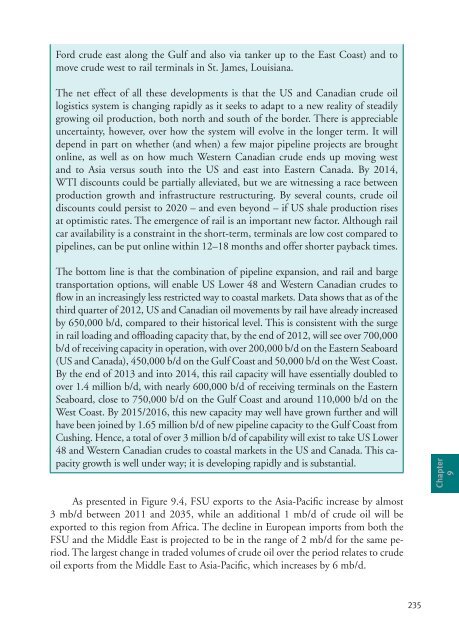World Oil Outlook - Opec
World Oil Outlook - Opec
World Oil Outlook - Opec
- TAGS
- world
- outlook
- opec
- www.opec.org
You also want an ePaper? Increase the reach of your titles
YUMPU automatically turns print PDFs into web optimized ePapers that Google loves.
Ford crude east along the Gulf and also via tanker up to the East Coast) and to<br />
move crude west to rail terminals in St. James, Louisiana.<br />
The net effect of all these developments is that the US and Canadian crude oil<br />
logistics system is changing rapidly as it seeks to adapt to a new reality of steadily<br />
growing oil production, both north and south of the border. There is appreciable<br />
uncertainty, however, over how the system will evolve in the longer term. It will<br />
depend in part on whether (and when) a few major pipeline projects are brought<br />
online, as well as on how much Western Canadian crude ends up moving west<br />
and to Asia versus south into the US and east into Eastern Canada. By 2014,<br />
WTI discounts could be partially alleviated, but we are witnessing a race between<br />
production growth and infrastructure restructuring. By several counts, crude oil<br />
discounts could persist to 2020 – and even beyond – if US shale production rises<br />
at optimistic rates. The emergence of rail is an important new factor. Although rail<br />
car availability is a constraint in the short-term, terminals are low cost compared to<br />
pipelines, can be put online within 12–18 months and offer shorter payback times.<br />
The bottom line is that the combination of pipeline expansion, and rail and barge<br />
transportation options, will enable US Lower 48 and Western Canadian crudes to<br />
flow in an increasingly less restricted way to coastal markets. Data shows that as of the<br />
third quarter of 2012, US and Canadian oil movements by rail have already increased<br />
by 650,000 b/d, compared to their historical level. This is consistent with the surge<br />
in rail loading and offloading capacity that, by the end of 2012, will see over 700,000<br />
b/d of receiving capacity in operation, with over 200,000 b/d on the Eastern Seaboard<br />
(US and Canada), 450,000 b/d on the Gulf Coast and 50,000 b/d on the West Coast.<br />
By the end of 2013 and into 2014, this rail capacity will have essentially doubled to<br />
over 1.4 million b/d, with nearly 600,000 b/d of receiving terminals on the Eastern<br />
Seaboard, close to 750,000 b/d on the Gulf Coast and around 110,000 b/d on the<br />
West Coast. By 2015/2016, this new capacity may well have grown further and will<br />
have been joined by 1.65 million b/d of new pipeline capacity to the Gulf Coast from<br />
Cushing. Hence, a total of over 3 million b/d of capability will exist to take US Lower<br />
48 and Western Canadian crudes to coastal markets in the US and Canada. This capacity<br />
growth is well under way; it is developing rapidly and is substantial.<br />
As presented in Figure 9.4, FSU exports to the Asia-Pacific increase by almost<br />
3 mb/d between 2011 and 2035, while an additional 1 mb/d of crude oil will be<br />
exported to this region from Africa. The decline in European imports from both the<br />
FSU and the Middle East is projected to be in the range of 2 mb/d for the same period.<br />
The largest change in traded volumes of crude oil over the period relates to crude<br />
oil exports from the Middle East to Asia-Pacific, which increases by 6 mb/d.<br />
235<br />
Chapter<br />
9
















